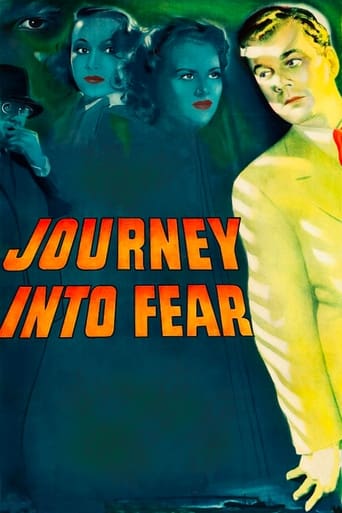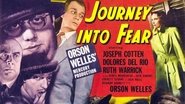JohnHowardReid
Joseph Cotten (Howard Graham), Dolores Del Rio (Josette), Ruth Warwick (Stephanie Graham), Orson Welles (Colonel Haki), Everett Sloane (Kopenkin), Agnes Moorehead (Mrs Matthews), Frank Readick (Matthews), Jack Durant (Gobo), Eustace Wyatt (Dr Haller), Edgar Barrie (Kuvetli), Jack Moss (Banat), Hans Conried (magician), Stefan Schnabel (purser), Richard Bennett (captain), Shifra Haran (Mrs Haller), Robert Meltzer, Herbert Drake, Bill Roberts (stewards), Ivan Lebedeff (headwaiter), Frank Puglia (Haki's aide), Torben Meyer, Alex Melish (waiters), William Yetter, senior (driver), Irene Tedrow (Greek woman), George Sorel (hotel desk clerk), Harry Semels (man in night club), Edward Howard, Robert Willey (men).Directors: NORMAN FOSTER, ORSON WELLES. Screenplay: Joseph Cotten, Orson Welles, Ben Hecht, Richard Collins. Based on the 1940 novel by Eric Ambler. Film editor: Mark Robson. Photography: Karl Struss. Supervising art director: Orson Welles. Art directors: Albert S. D'Agostino and Mark-Lee Kirk. Set decorators: Darrell Silvera and Ross Dowd. Costumes designed by Edward Stevenson. Special effects: Vernon L. Walker. Music: Roy Webb. Music director: Constantin Bakaleinikoff. Song, "Three Little Words" (sung mostly in Turkish), by Bert Kalmar (lyrics) and Harry Ruby (music). Technical adviser: Eugen Sharin. Assistant director: Dewey Starkey. Sound recording: Bailey Fesler, Richard Van Hessen. Sound re-recording: James G. Stewart. RCA Sound System. Associate producer: Jack Moss. Producer: Orson Welles. Executive producer: George J. Schaefer. Copyright 12 February 1943 by RKO-Radio Pictures, Inc. A Mercury Production. New York opening at the Palace (as the main attraction on a double bill with Silver Skates): 18 March 1943. U.S. release: 12 February 1943. U.K. release: October 1943. Australian release: 11 February 1943. Sydney opening at the Mayfair: 5 February 1943. Australian length: 6,508 feet. 72 minutes. U.S. release length: 68 minutes. SYNOPSIS: A not over-bright American businessman tangles with Nazi spies in the Balkans.NOTES: The above details apply to the second (definitive) version of the film cut by Orson Welles. A first version was released on 7 August 1942. Welles re-cut the last scene on the hotel balcony and added a letter-reading framework. COMMENT: Despite Foster's name on the credits, this is a Welles film through and through. The climax is a real stunner and Jack Moss' performance as the silent assassin is absolutely chilling. This is his only on-camera appearance. A pity. He makes a marvelous menace. (He produced a few films including The Shepherd of the Hills in 1941). Eustace Wyatt also makes quite an impression as Haller/Muller, and Delores Del Rio, as usual, is wonderfully exotic. Prefiguring his role in "The Third Man", Joseph Cotten makes his bumbling American abroad utterly convincing. Attractively low-key photography, plus impressive sets, contribute effectively to the film's broodingly suspenseful atmosphere.
steven_17
Orson Welles and Joseph Cotton made several great films together through the 40s/50s one of which is the overlooked Journey Into Fear. It is a kind of surreal, absurdist thriller about war, identity and the stripping away of identity that turns a cowardly man in denial into a soldier...of sorts. Howard Graham very deliberately goes to Turkey with his wife so he can be tied to an X by a magician and have an attempt made on his life, which kills the magician and sends him into hiding on a boat on its way to the mainland. All the while he maintains the disguise of being the victim and of not wanting to get involved and of being just a businessman with no part in the war, despite being a representative of a munitions company. His wife is sent to take the train while he must be separated from her and sent adrift on the boat. This tale is very cleverly disguised in a World War 2 story but still works on both levels. Everyone knows what Graham denies himself. The Colonel who sends him away on the boat can see right through him and knowingly comments on his choice to arm himself. I find these moments funny, such as Graham clearly immersing himself in the role in private with his revolver in his cabin, clearly relishing the freedom. Everyone on the boat can see right through him, and they all appear to be stuck in their own reverie or loop, otherwise in the case of the Captain they just laugh at him as he impotently whines that there's a man on the boat trying to kill him and mock his false pleas. In one brilliant scene a tobacco salesman explains how he was scolded by his wife for making remarks and talking nonsense as if he were a mere worker, which he is at heart, then says he gained freedom at home by threatening to do so again. Like Graham, he overstepped his bounds and by doing so overcame his fear and now lives comfortably in illusion. I could go into it further, but this film is not so overt in the way it expresses its ideas so it would take longer, whereas a different kind of film like say, Metropolis, makes it very easy as the images speak for themselves, but that is a different film from a different era and being a genre film Journey Into Fear must be disguised in order to sell itself. In another scene another liberated soul gazes out to the sky and asks "what is better, to see the land from a ship, or a ship from the land?," and comes to the conclusion that he dislikes both and so takes simple comfort merely from the respiratory system that keeps him alive, another experienced man who has been liberated through time and lives a glad life dreaming aboard the boat. While they all talk of the war and its folly and how terrible it is (really the inner war of Mr. Graham), one man, a businessman, gets up and says that "war is bad for business," and it is as it seems to contradict the flow of events and cause the individual confusion. Mr. Graham, in the letter he is writing through the film from its end, apologizes to his wife for hooking up with a dancing girl on the boat he met in a club at the start of the film. She tags along with him but he just uses her as a comfort as he faces his fear of death and of his own doubt. Finally he is confronted by the man who has hired the assassin to kill him in his cabin, who has his gun aimed at him and bluntly tells him that he lucky because he is going to catch Typhus. Rightfully confused by this statement and by Muller's half assed plan he seeks to finally do something about it and when they get off the ship and he is held in a car, he disables the driver and crashes the car before reuniting with the dancer girl and his wife at a hotel, where the Colonel is also waiting. In the final showdown, on a precarious ledge high up in the pouring rain, he is finally forced into action when the Colonel, his uniformed "Turkish" protector is shot and falls back through the glass into one of the rooms, and he finally accepts his role and kills his would-be assassin. There are two different versions of the film, one with a great ending, one with a not-so-good ending. One version has his wife call up to him that he'll "catch his death of cold," and then it just ends, and the better version has him finish the letter he's been recounting the events of the film in only to scrap his version and walk through the doors to his newfound courage and freedom. Thankfully the bad ending is just on the TV version.
Leofwine_draca
A fun noir thriller, teaming Joseph Cotten (SHADOW OF A DOUBT) and Orson Welles (CITIZEN KANE). An arms dealer in Turkey finds himself the subject of an assassination plot by Nazi agents who are determined to stop him helping the alliance. The story begins proper during a magic show when a magician is accidentally shot; the intended victim (Cotten) must then flee on a ship back to America, but all on board may not have kindly intents towards him.Oddly, the film this most reminded me of is the fun Sherlock Holmes story PURSUIT TO ALGIERS, which has a very similar storyline. In any case, JOURNEY INTO FEAR is a fun film to watch for the visuals, featuring plenty of moody black-and-white photography and menacing shadows from which an assassin could spring at any moment. The story picks up when the setting moves to the ship, the director making the best of the claustrophobic confines.Cotten has always been a reliable star and that's no different here. Welles himself plays the larger-than-life supporting role of a Turkish ally, while the villains pitted against the pair are a lot of fun. The high rise climax is a hoot.
Spikeopath
Well it says Journey Into Fear was directed by Norman Foster, but many sources say it was actually Orson Welles who directed it. Possible of course since this Mercury Theatre production was produced, co- written {with co-star Joseph Cotton} and starred big Orson himself. But wait! Welles is on record as saying he did no directing on the film and it was his friend Foster in the chair. Except for Welles' own scenes which were directed by anyone handy since they were rushing because Welles was due in Brazil to film It's All True! There has also been re-cuts by Welles, added scenes and a narration at the beginning and end that has been and gone over the years. It's all appropriate confusing conjecture tho since the film itself has a strange quirkiness nestling within its arresting visuals.The story is based on Eric Ambler's highly regarded spy thriller, and sees Howard Graham {Joseph Cotton} as an American engineer, who after a conference in Turkey finds that someone is trying to kill him. We are then thrust into a murky world of espionage where everybody, their motives, and their identities are suspect. Graham is the classic innocent man abroad, we the viewers, as well as everyone in the story but Graham, knows more than he does! I bet Hitchcock loved this film for it be right up his alley. The majority of the film takes place aboard a cramped dilapidated liner, this gives off a wonderfully claustrophobic feel to proceedings. The stifling nature further enhanced by the fact that 99% of the film is set at night time, with Karl Struss' photography utilising shadows and exuding an almost bizarre menacing sheen. There's some nice technical Welles trademarks in here, such as crane shots {the opening scene is moodily awesome} and Welles' well publicised love of magic is given a cute nod during one particularly impacting sequence.Along side Cotton the cast contains solid performers like Dolores del Rio, Everett Sloane, Ruth Warwick and Agnes Moorehead. But it's Cotton who rightly makes the big impact. Understated and quiet, his Howard Graham infuriates with his inability to grasp what is going on, or to act at times when it clearly calls for the swift clank of brain being put into gear. A real smart bit of casting here from Foster, Welles or whoever! Journey Into Fear, for texture and technical composition belongs in the film-noir genre, certainly as far as the early cycle goes. But really it's a film for the general cinema purists, at times brilliant, at others chaotic, it remains engrossing from start to finish. See it if you can. 8/10




